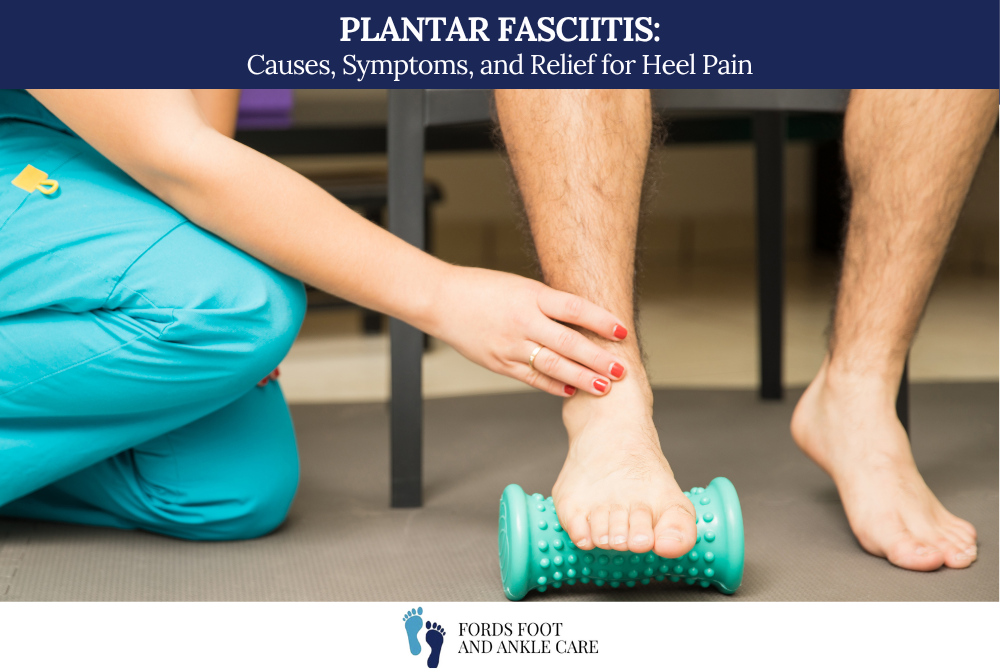
Plantar fasciitis is one of the most common causes of heel pain, affecting millions of Americans each year. Characterized by a sharp, stabbing pain at the bottom of the heel, this condition can make walking, standing, and even getting out of bed a painful challenge.
At Fords Foot and Ankle Care, we understand how debilitating plantar fasciitis can be—and we’re here to help. Whether you’re experiencing early signs or have been dealing with chronic heel pain for months, our expert team offers personalized treatment options to get you back on your feet pain-free.
What Is Plantar Fasciitis?
Plantar fasciitis occurs when the plantar fascia—a thick band of tissue that runs along the bottom of your foot—becomes inflamed or irritated. This tissue supports the arch of the foot and absorbs shock during walking or running. When it’s overstressed or damaged, it can lead to heel pain and inflammation.
Common Causes and Risk Factors
Plantar fasciitis is often the result of repetitive stress or strain. Common causes and contributing factors include:
- Flat feet or high arches
- Wearing unsupportive shoes
- Prolonged standing or walking on hard surfaces
- Tight calf muscles or Achilles tendons
- Sudden increase in physical activity
- Excess body weight
- Occupations that require standing for long periods (e.g., teachers, nurses, retail workers)
Symptoms of Plantar Fasciitis
- Sharp pain at the bottom of the heel
- Pain that is worse in the morning or after periods of rest
- Pain that improves with activity but returns after standing or walking
- Mild swelling or warmth around the heel
Diagnosis and Treatment Options
At Fords Foot and Ankle Care, we begin with a comprehensive exam and may use imaging such as X-rays to rule out other causes like heel spurs or stress fractures.
Non-Surgical Treatment Options:
- Rest and activity modification
- Ice therapy
- Custom orthotics or arch supports
- Stretching and strengthening exercises
- Supportive footwear recommendations
- Night splints
- Anti-inflammatory medications
- Corticosteroid injections for severe pain
Advanced Treatment Options:
- Shockwave therapy (ESWT)
- Platelet-rich plasma (PRP) therapy
- Minimally invasive procedures
Surgery is rarely needed but may be considered in chronic, treatment-resistant cases.
FAQs About Plantar Fasciitis
Q: How long does it take to heal from plantar fasciitis?
A: With proper care, most people recover within 6 to 12 weeks. Chronic cases may take longer. Early intervention can significantly shorten recovery time.
Q: Can plantar fasciitis go away on its own?
A: Mild cases may improve with rest and lifestyle changes, but without targeted treatment, the condition can become chronic and more difficult to manage.
Q: Are heel spurs the same as plantar fasciitis?
A: No. Heel spurs are calcium deposits on the heel bone and can occur with plantar fasciitis, but they are not the cause of the pain in most cases.
Q: What type of shoes should I wear if I have plantar fasciitis?
A: Choose shoes with strong arch support, a cushioned heel, and a slightly raised heel-to-toe drop. Avoid flat shoes and flip-flops.
Q: Can stretching help relieve symptoms?
A: Yes! Stretching the calf muscles, Achilles tendon, and plantar fascia itself can significantly reduce pain and prevent flare-ups.
Don’t Let Heel Pain Hold You Back
Plantar fasciitis can severely impact your quality of life, but the good news is that it’s highly treatable. The earlier you seek care, the faster you can return to your regular routine—without pain.
If you’re experiencing heel pain, we encourage you to schedule a consultation at Fords Foot and Ankle Care. Our experienced team will develop a treatment plan tailored to your lifestyle and level of activity.
Contact Information
Fords Foot and Ankle Care
📍 519 New Brunswick Ave
Fords, NJ, 08863
📞 Phone: (732) 738-4441
🌐 Website: fordsfootandanklecare.com
Take the first step toward relief—contact us today and let’s get you back on your feet.
